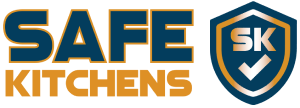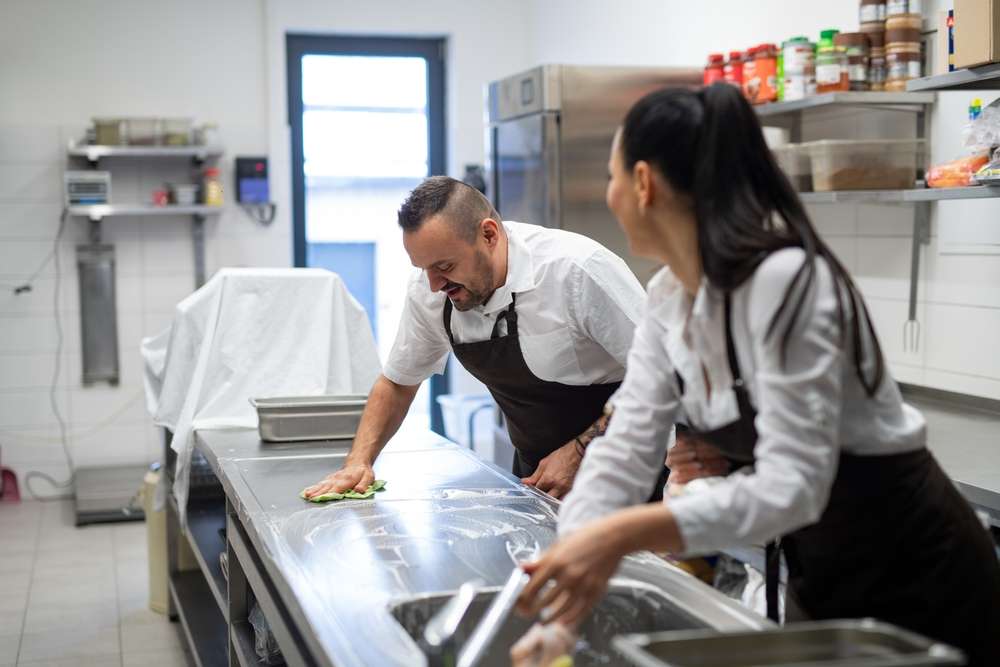Weekly Commercial Kitchen Cleaning Checklist
Maintaining a clean and hygienic commercial kitchen is a fundamental requirement for any foodservice establishment. Regular cleaning not only ensures the safety of your kitchen but also enhances the efficiency and productivity of your staff. To help you stay on top of kitchen cleanliness, we’ve created a comprehensive weekly commercial kitchen cleaning checklist.
This restaurant cleaning checklist is divided into two sections: the back-of-house cleaning checklist, which focuses on the kitchen’s functional areas, and the front-of-house cleaning checklist, which ensures a welcoming environment for your customers.
Preparing for Cleaning
Before beginning your weekly kitchen cleaning routine, be sure to do adequate preparation. Here are the key steps to prepare for a successful kitchen cleaning session, including gathering necessary supplies and equipment and ensuring proper ventilation and safety measures.
Gathering Necessary Supplies and Equipment
Cleaning a commercial kitchen demands the right tools and materials. Without them, the process can be arduous and ineffective. Here’s a checklist of supplies and equipment you should gather:
1. Cleaning Agents
Select the appropriate cleaning agents for different surfaces and areas in the kitchen. Common options include degreasers, sanitizers, and disinfectants. Ensure you have sufficient quantities of each.
2. Cleaning Tools
Invest in quality cleaning tools, such as scrub brushes, microfiber cloths, mop buckets, and sponges. Having a variety of tools allows you to tackle different tasks effectively.
3. Safety Gear
Safety should be a top priority during kitchen cleaning. Depending on the chemicals used, you may need personal protective equipment like gloves, goggles, and aprons. Ensure they are readily available for use.
4. Trash Bags and Containers
Prepare trash bags and containers for the disposal of waste generated during cleaning. Regularly empty these containers to prevent overflow and odors.
5. Maintenance Tools
Inspect and maintain equipment like vacuum cleaners, steam cleaners, and pressure washers, ensuring they are in working order. Any malfunctioning tools should be repaired or replaced promptly.
6. Labels and Signage
Be sure to label hazardous areas or chemicals and provide clear signage so that your staff and visitors are aware of potential risks during the cleaning process.
Ensuring Proper Ventilation and Safety Measures
Safety and ventilation are non-negotiable aspects of kitchen cleaning. Here’s how to maintain them effectively:
1. Ventilation
Proper ventilation is essential to prevent the buildup of fumes from cleaning agents. Ensure that your kitchen has functioning exhaust fans and open windows to allow fresh air circulation. Having enough ventilation reduces the risk of respiratory issues and makes sure you have a safe environment.
2. Safety Measures
Safety during kitchen cleaning should never be compromised. To maintain a safe environment:
- Communicate the cleaning schedule to staff and ensure they are aware of potential hazards.
- Block off areas under maintenance, indicating restricted access.
- Make sure staff are trained in using cleaning agents safely and are familiar with emergency procedures in case of accidents.
- Adequately ventilate the storage and disposal areas for cleaning chemicals to prevent the risk of leaks or spills
Back-of-House Cleaning Checklist
The back-of-house area is where you prepare your food, so it must be kept clean. To maintain a safe and efficient workspace, it’s essential to perform thorough cleaning tasks each week. Here’s a restaurant cleaning list to help you keep your kitchen spotless:
1. Clean and Sanitize Food Preparation Surfaces
- Scrub and sanitize all food preparation surfaces, including cutting boards, countertops, and food prep tables.
- Pay special attention to surfaces in contact with raw proteins to prevent cross-contamination.
- Clean and sanitize food storage shelves and containers.
2. Clean Kitchen Equipment
- Wipe down and sanitize all kitchen equipment, including stovetops, ovens, fryers, and grills.
- Remove and clean the grates and burners from stovetops.
- Check and clean the interior of ovens and grills.
- Clean and sanitize the exterior of equipment.
3. Check Refrigerators and Freezers
- Empty and clean the interior of refrigerators and freezers.
- Disinfect shelves and drawers.
- Ensure that temperature logs are maintained.
4. Dishwashing Area Cleaning
- Clean and sanitize sinks and dishwashing machines.
- Scrub the dishwashing area, including counters and dish racks.
- Empty and clean dish racks.
- Check and clean dishwasher filters.
5. Floor Maintenance
- Sweep and mop the kitchen floor.
- Pay attention to hard-to-reach areas and corners.
- Check floor drains and ensure they are clear of debris and sanitized.
6. Grease Trap Cleaning
- Empty and clean the grease trap.
- Inspect and replace grease trap filters if necessary.
7. Hood and Exhaust Cleaning
- Inspect and clean the hood and exhaust system.
- Remove and clean grease filters.
- Schedule professional hood and exhaust system cleaning as needed.
8. Cleaning of Walls and Ceilings
- Scrub and sanitize walls, especially in areas prone to splashes.
- Dust and clean ceiling vents and fixtures.
- Inspect and clean air ducts if necessary.
9. Pest Control
- Regularly inspect for signs of pests, such as rodents or insects.
- Maintain pest control measures to prevent infestations.
Front-of-House Cleaning Checklist
A clean and inviting front-of-house area is essential to creating a positive dining experience for your customers. Use this checklist to ensure the cleanliness and orderliness of your restaurant’s public areas:
1. Entrance and Waiting Area
- Sweep and mop the entrance area to remove dirt and debris.
- Clean and sanitize waiting area furniture.
- Ensure the entrance is free of clutter and obstructions.
2. Dining Area Cleaning
- Wipe and sanitize tables and chairs.
- Check table settings and replace linens or tableware if necessary.
- Clean and sanitize highchairs and booster seats.
3. Floors and Carpets
- Sweep and vacuum dining area floors and carpets.
- Deep clean carpets as needed to remove stains and odors.
4. Restroom Cleaning
- Clean and sanitize restrooms regularly throughout the day.
- Check and restock essential supplies, including toilet paper, soap, and paper towels.
- Clean mirrors and refill hand sanitizer stations.
5. Windows and Glass
- Clean and sanitize windows, glass doors, and partitions.
- Remove fingerprints, smudges, and marks for a sparkling appearance.
6. Bar Area Cleaning
- Clean and sanitize the bar area, including bar counters, stools, and glassware.
- Check the condition of bar equipment and utensils.
7. Light Fixtures and Decorations
- Dust and clean light fixtures, chandeliers, and decorative items.
- Ensure that all bulbs are in working order.
8. Entryway and Exteriors
- Sweep and clean the entryway to remove debris and dirt.
- Ensure exterior signs and lighting are well-maintained and illuminated.
9. Outdoor Seating Areas
- Sweep and clean outdoor seating areas.
- Check and maintain outdoor furniture.
- Remove debris from patios, decks, or outdoor dining spaces.
Maintain a Clean Commercial Kitchen with Safe Kitchens
Regular weekly cleaning of both the back-of-house and front-of-house areas is essential for the success of any foodservice establishment. Maintaining a clean and safe kitchen ensures the safety of your food and staff, while a well-kept front-of-house area provides a welcoming environment for your customers.
By following this restaurant kitchen cleaning checklist, you can stay on top of your cleaning routines and provide a dining experience that is not only delicious but also enjoyable and hygienic.
To hire a commercial kitchen cleaning service in Los Angeles and surrounding areas, contact us today.

